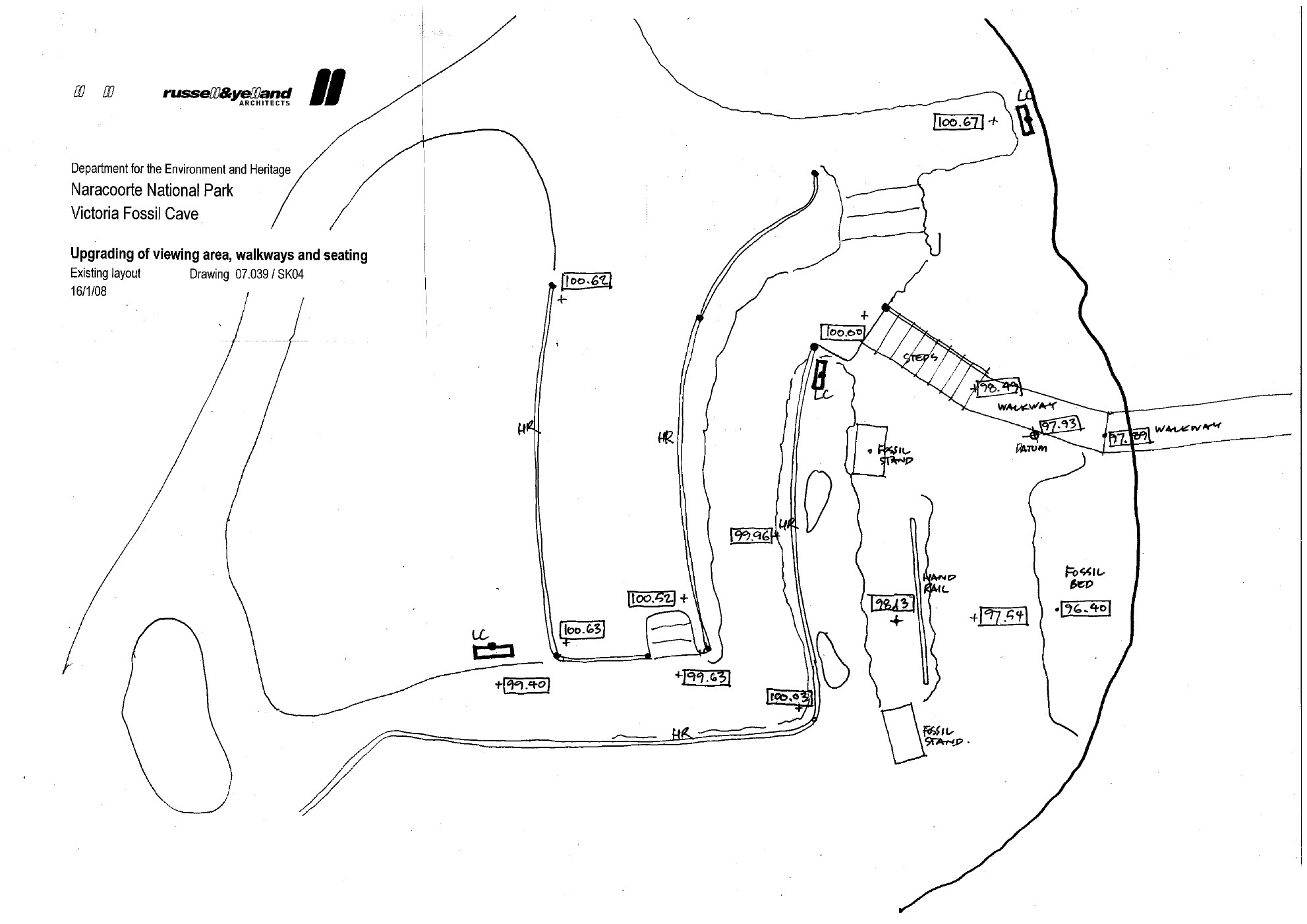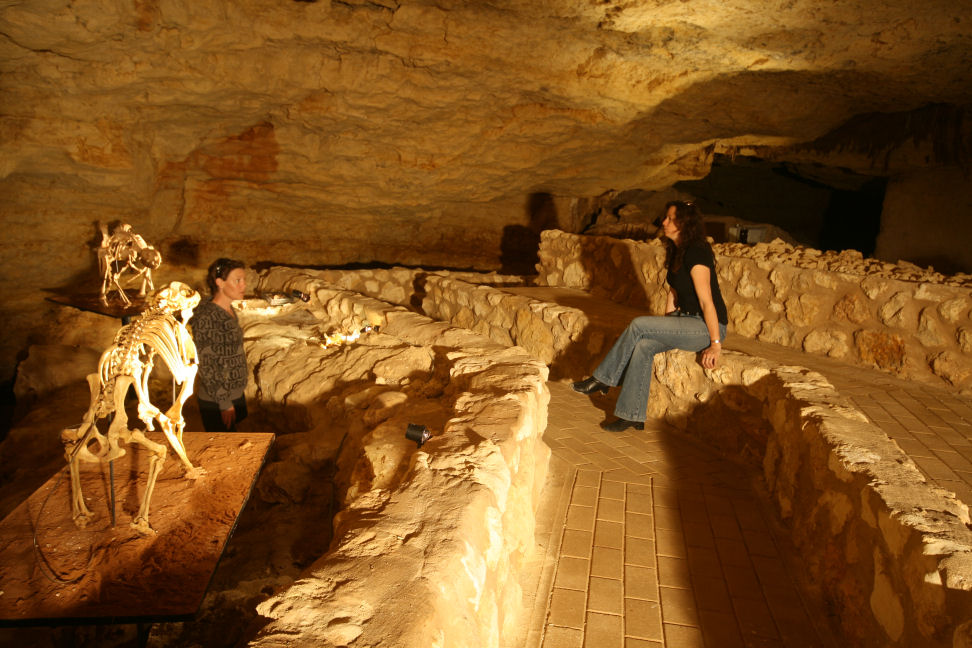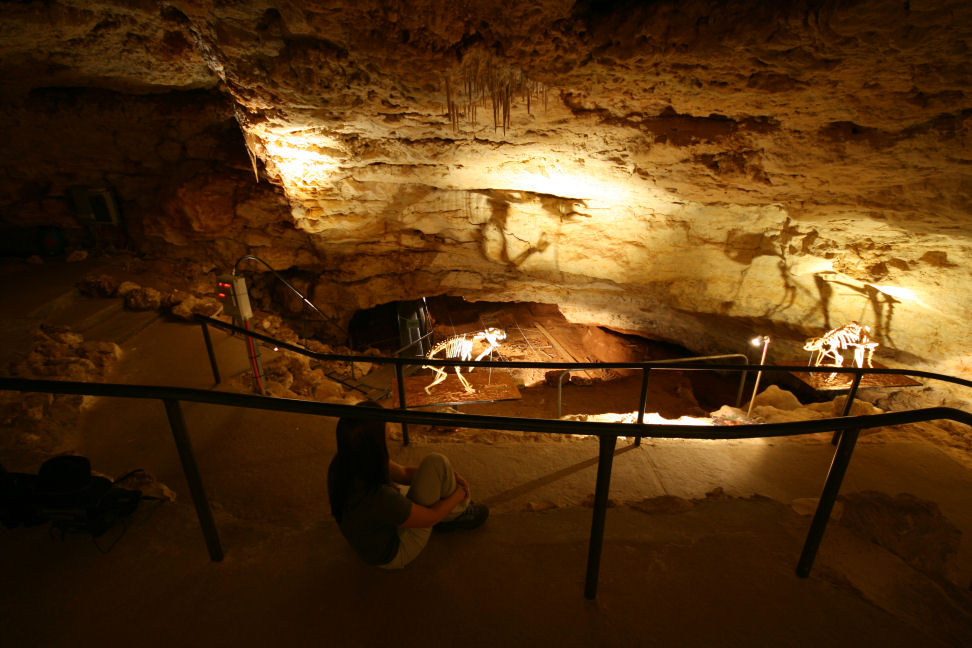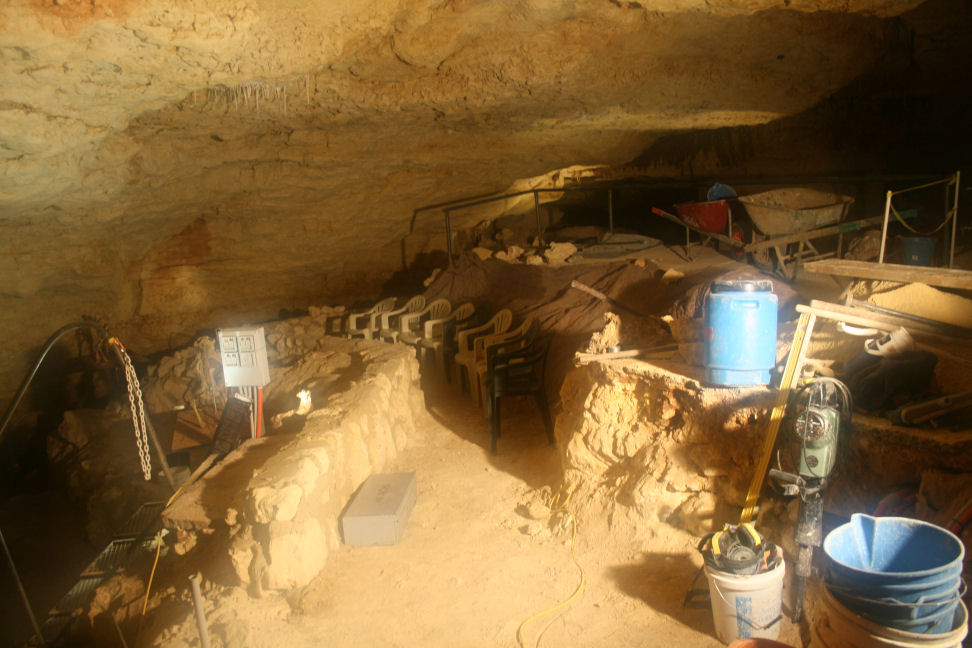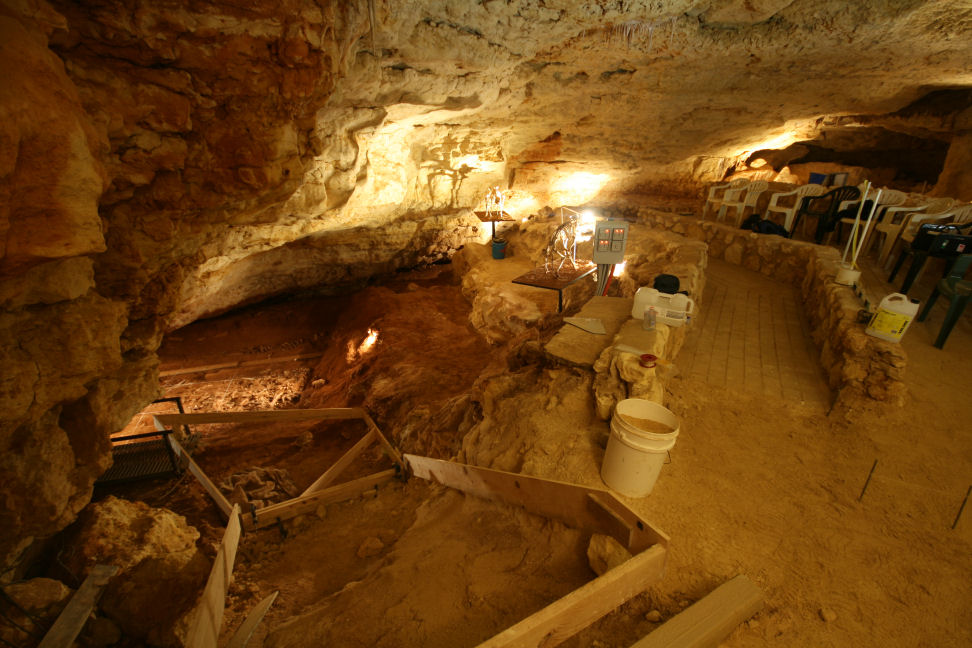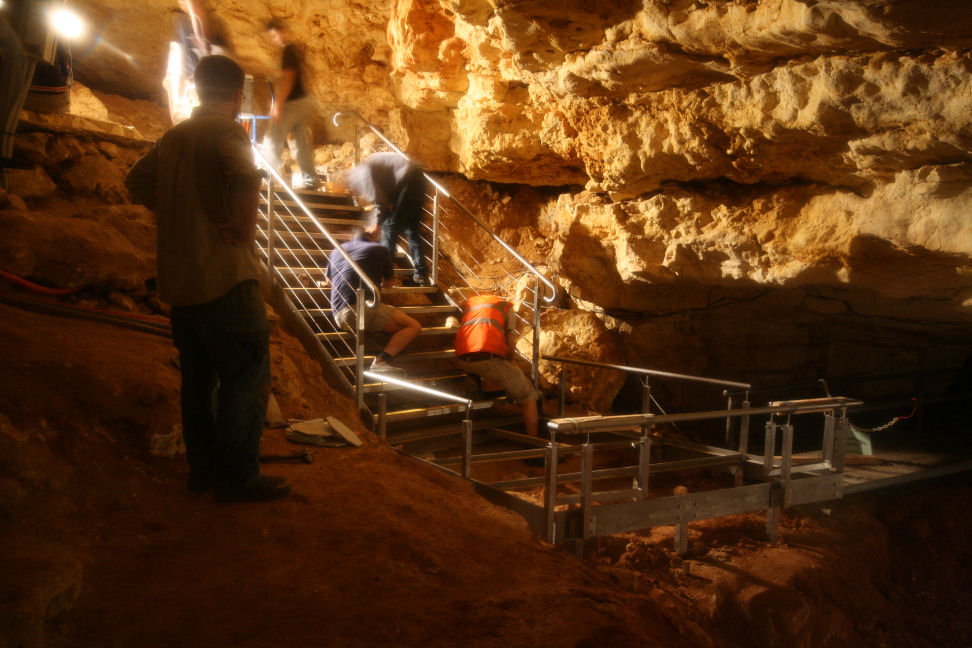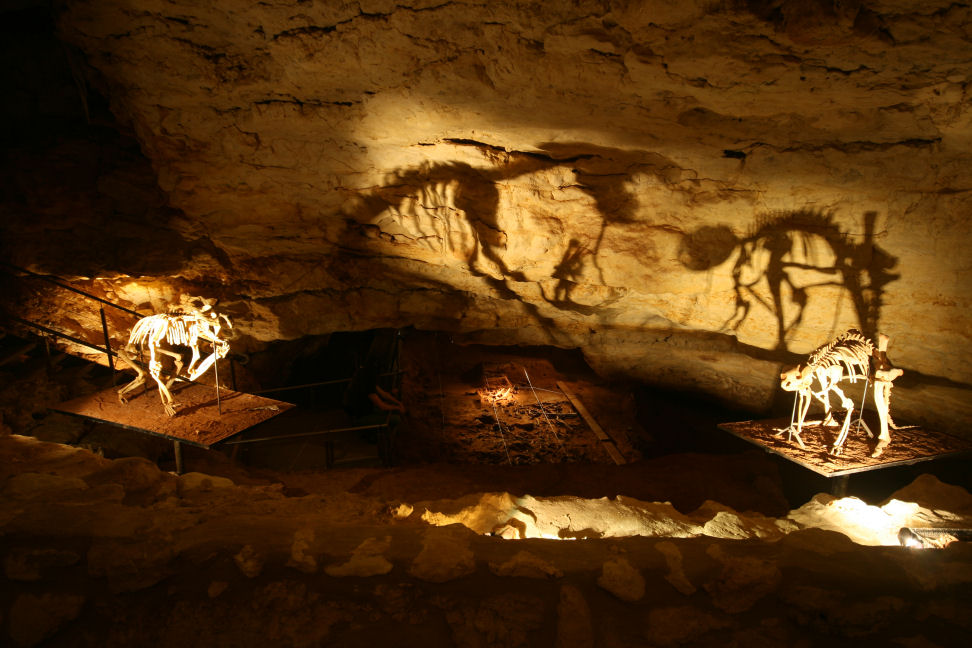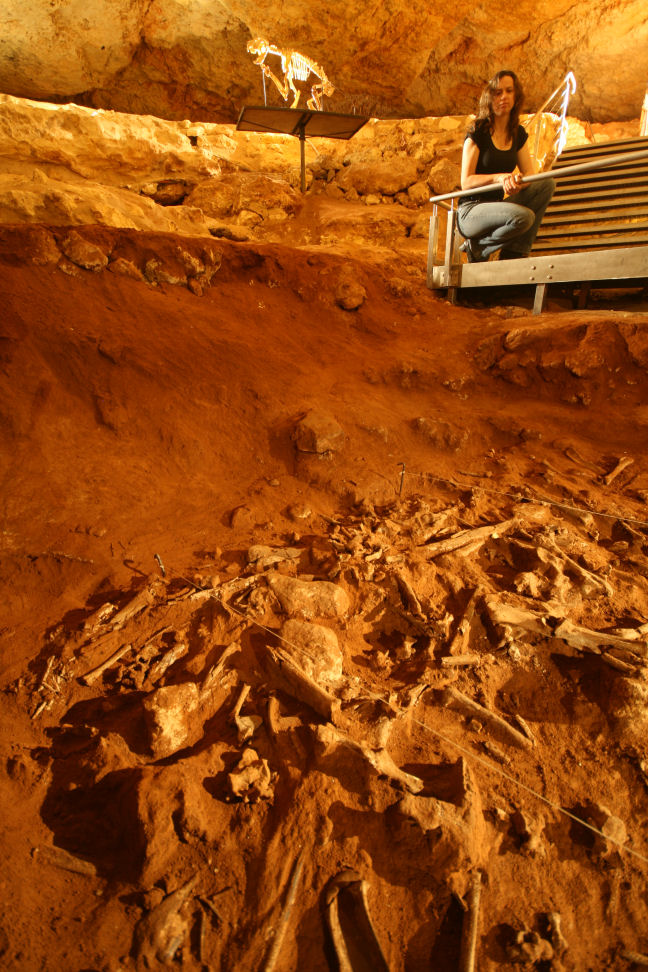Close to the bone: Revamping the Victoria Fossil Cave visitor experience.
Department for Environment and Heritage PO Box 134 Naracoorte SA 5271. bourne.steven@saugov.sa.gov.au
Abstract
The viewing area in Victoria Fossil Cave was established in 1970 to allow visitors to the cave to view the fossils deposit. It was built during a phase of active research when researchers were often in full view and able to speak to visitors about recent discoveries. The original infrastructure elevated visitors but there were many shortcomings with the design.
- Line of sight for visitors was compromised with handrails interrupting the view of the deposit.
- Visitors were a substantial distance from the deposit and close up viewing not possible without compromising safety of visitors and fossils.
- Visitors could get no sense of the size of the deposit due the cave morphology.
- Materials used in infrastructure were by today’s standards inappropriate, steel handrails that had rusted. The paths and platform were concrete.
The redevelopment set out to achieve 7 objectives
- To create a clearer view of the deposit when viewed from a distance.
- To allow visitors a close up view of fossils.
- To provide visitors with a view of the entire deposit to give a better sense of its dimensions.
- To utilise more cave friendly materials for protection of the cave environment and utilise “reversible” infrastructure-for easy removal when the time comes.
- To create a more comfortable and flexible working environment for site interpreters.
- To create a more comfortable environment for visitors.
- To create a more immersive, interactive visitor experience
This paper outlines the thinking and processes behind the redevelopment of the viewing area, difficulties and how they were overcome.
Introduction
Naracoorte Caves National Park is a World Heritage Site listed for extensive fossil remains found within caves in the park. Although fossils were reported as early as the 1860’s (Woods 1862) with additional small finds in 1908, fossils as a tourism product was not implemented until 1970 after the discovery of an enormous fossil deposit (now called the Fossil Chamber) in Victoria Cave (now Victoria Fossil Cave). The site was developed with the objective of linking research to tourism and was complemented with a display in a small visitor centre (Wells et al 1979, White 1999). Development was constrained by difficulties creating access to the Fossil Chamber and by materials available at the time. The cave was relit in 1993 with some sections of Victoria Fossil Cave improved with the removal of rubble left through creating visitor access, replacing out dated infrastructure and further upgrading of lighting systems (Bourne & Bradford, 2003). The Fossil Chamber itself was largely the same as it was first developed with concrete paths and galvanised steel handrails. A grant was received from the Australian Government through the Natural Heritage Trust World Heritage program. This paper describes the redevelopment of the Fossil Chamber and recreating a more immersive visitor experience.
Fossil Presentation
Fossils have been an integral part of the Naracoorte Caves experience since 1970. Access to the Fossil Chamber was established soon after its discovery through a partnership and vision of both management and researchers to present science as a tourism product (Wells et al 1979). Initially, visitors could interact with scientists excavating on their monthly forays to the site and witness exciting discoveries first hand. After five years trips became less frequent and then focussed on sections of the deposit away from visitors line of sight. A display interpreting the fossil history was established at the main visitor precinct approximately 1.5km north of the cave.
Small improvements were made to the presentation of the Fossil Chamber with a replica skeleton of a extinct short-faced kangaroo Simosthenurus occidentalis and later a Marsupial Lion Thylacoleo carnifex added. Site Interpreters’ in cave resources were regularly updated including sketches of extinct megafauna, casts and modern comparative bone material. Presentation of the fossil values was greatly enhanced with the opening of the Wonambi Fossil Centre 4 December 1998. The computer-animated models of extinct megafauna brought the fossils “to life” for visitors and established a focal point for regional tourism.
Despite the significant investment in fossil presentation above ground and advances in other areas of Victoria Fossil Cave, the main infrastructure in the Fossil Chamber had not been altered since its installation. The visitor experience offered was no longer adequate at a World Heritage Site so a project was developed and funding sought for its implementation. A grant of $100,000 was received from the Australian Government through the World Heritage program within the Natural Heritage Trust.
Project Objectives
A number of objectives were established for the project as a sub set of the overall goal of improving the visitor experience, in line with Guidelines for Cave and Karst Protection (Watson et al 1997) and based on principles outlined by Hamilton-Smith et al (1999) and Spate et al (1999).
- To improve viewing of the fossil bed from a distance
- To allow visitors a close up look of the fossil deposit
- To provide visitors with a view of the entire deposit
- To remove old infrastructure and replace with more cave-friendly materials
- To create a more flexible working environment for site interpreters
- To improve comfort for visitors
- To create a more immersive, interactive visitor experience
Project implementation
Consultation
Many stakeholders were consulted with this project. Fossil values at Naracoorte are protected under the World Heritage Convention 1972 and the South Australian National Parks and Wildlife Act 1972. In addition, Victoria Fossil Cave has been placed on the South Australian State Heritage Register. Palaeontologists were consulted regarding the placement of infrastructure closer to the fossil deposit than was currently in place; a heritage advisor gave advice on state heritage, and approval sought from the local council regarding development on a State Heritage Site. The project was also discussed with a number of ACKMA members and a huge number of cave sites visited to view the materials that other cave sites were using. An ambitious plan was conceived to lower the main viewing platform by at least 60cm and over one metre at one point and install a new close up viewing platform immediately adjacent to the fossils. One of the major challenges to overcome was how to implement the project without closing the cave to visitors and continuing to provide satisfactory tours while the work was being completed.
Design
An architect was engaged to design the close-up viewing platform. The chamber was carefully surveyed and mapped and preliminary drawings provided. It became apparent that to enable Australian standard stairs to be built down to the platform even more rock than was originally thought would need to be removed. The drawings proved to be extremely valuable as they enabled contractors to be engaged to construct the stairs and platform while concrete and rock were being removed and the site was being prepared.
Stainless steel was the obvious choice as the frame for the platform. The handrail chosen was a 38mm dimpled 316 grade stainless steel rail, selected for grip, durability in the cave environment and low sheen. A similar product had been noted in Waitomo but apparently is a rarely used product as it took many months to find a potential supplier. A fibreglass composite marketed as “Envirowalk” was chosen for stair treads and platform, a product used at Chillagoe and Jenolan and probably other cave sites.
Potential suppliers for the production and installation were sought and the successful tender had one strategy that separated his team from others: he would construct a timber replica and ensure this fitted prior to commencing work on the stainless steel final product to guarantee an exact fit. This was fortunate, as modifications were required to both the final drawings and to remove further rock from the cave to ensure a perfect fit. It also significantly reduced impacts on the cave with all welding construction in the workshop also giving a better engineered result.
Removing old infrastructure
Prior to the submission of the funding application, Conservation Volunteers Australia (CVA) was contacted regarding the possibility of their crews undertaking the bulk of the concrete and rubble removal. With approximately one third of available funds allocated to the stairs and platform and nearly the same for improving lighting, it left less than $40,000 for site preparation and establishing new paths. Engaging contractors or employing extra staff to undertake the work would have been well beyond the budget.
CVA supplied teams of volunteers, mostly international on the basis of one week paid and one week cost covered by one of their corporate sponsors. Teams varied in size with up to eight people and a supervisor supplied. Work commenced in December 2007 and removed approximately five square metres of concrete path and rock to a depth of approximately one metre. This work was just beyond the access for visitors and site interpreters hence minimal disruption to cave tours. All material was removed from the cave which involved placing it in ten litre buckets, carrying approximately 30 metres and down a short staircase, placing six buckets in a wheelbarrow and transporting over 50 metres along the concrete pathway to the winch hole; an 18 metre deep, half metre diameter shaft drilled into the cave in the 1970’s as an access point for construction materials. Buckets were then emptied into a 60 litre steel bucket and lifted to the surface using an electric winch and emptied in a trailer to the transported away from the site. At peak efficiency ten cycles of the 60 litre bucket could be achieved each hour. The task appeared daunting to say the least, but with energetic volunteers working as a team progress was quicker than expected.
Work was halted over the summer holiday period and commenced again as visitation slowed. Keeping the cave open and tours running became challenging and a strategy was employed. Work would commence before 8 am and continue until 10.30 am when the site was prepared for visitors. Plastic chairs were brought in as seating and tools and the worksite covered with hessian. It was fairly crude, but effective however visitors seemed to quite understand that it was work in progress and appreciative they could still visit the cave. Workers left the cave by 10.45 am and returned at 11.30 am. The next shift would continue until 2.30 pm when the cave was again prepared for visitors. Workers entered the cave again at 3.30 pm and continued until exhaustion set in or enthusiasm waned. Working conditions were so humid and the work so demanding a change of shirt was necessary for every shift! All steel handrails, approximately 50 metres were removed from the cave when it was deemed safe enough for visitors to access without them.
Teams exchanged after five days although one extremely enthusiastic hard working English volunteer stayed for the entire ten day shift. His dedication to the project was apparent when he returned after Easter for the final shift. A Green Corps team working on the park were enlisted for the final push to completion. A total of 170 “person days” were taken to remove approximately 30 square metres of concrete path and 20 cubic metres of limestone rubble. It was felt that most of what was removed was material originally moved to the site to establish the viewing platform, confirmed when cigarette packets and soft drink cans were recovered from deep within the removed material.
Installation
As rock and concrete removal was progressing, retaining walls were constructed. In some sections it was possible to use the natural cave as a barrier. In keeping with the objective of improving viewing, all modifications were made to ensure safe visitor access could be achieved without handrails except those on the stairs and viewing platform. Retaining walls were constructed from rocks broken up from the old viewing platform to reduce (albeit slightly) the amount of material to carry out of the cave.
Pavers were chosen to replace the concrete floor for relative ease of installing and their removability should alterations be required in the future. Brick size limestone coloured pavers were selected over larger pavers for largely aesthetic reasons. Once the floor level was close to the desired level, it was pounded with crowbars and sledgehammers to provide the necessary base material for laying pavers. A small amount of limestone “crusher fines” were brought into the cave for a level surface for paving. The Green Corps team transported the pavers into the cave as back loads for the winch removing rubble. Like every other part of the project, it was laborious and demanding but achieved through persistence of the crews involved.
The laying of the pavers was possibly the easiest part of the project. All cutting was done outside the cave to avoid dust and all paving completed in two short days.
The stainless steel and Envirowalk viewing platform was constructed external to the cave and brought into the cave in sections. Installation was completed in five hours.
Part of the project was the upgrade of lighting to create more mystery and atmosphere in the Fossil Chamber. A Clipsal C-Bus system was chosen because of its remote capabilities and for the ability to “ramp” lights on and off. To maintain consistent lighting throughout the cave, dichroic lamps were chosen rather than upgrading to LED technology. It is proposed to upgrade the entire cave in the short term. The C-Bus system was only installed in the Fossil Chamber as the linear nature of the rest of the cave provides limited opportunity for the system.
The final result
The project was completed in July 2008. The new viewing area has been well received by cave visitors and site interpreters alike. All objectives were met and the project came in on budget. The new infrastructure meets the current best practice in cave management and will be easily removed should the need arise in the future. It could not have been achieved without the use of volunteers of Conservation Volunteers Australia and Green Corps. Their teams’ dedication and commitment to achieving the best possible result ensured success and made it a most enjoyable project. The ongoing support from the Australian Government through the World Heritage funding program has greatly improved the presentation and management of the Naracoorte Caves World Heritage site.
References
Bourne, S.J. & Bradford, P.G. (2003) Victoria Fossil Caves-making it a cave once again. In Proceedings of the fifteenth Australasian Conference on Cave and Karst Management.
Hamilton-Smith, E., McBeath, R. & Vavryn, D. (1999) Best practice in visitor management. In Proceedings of the twelfth Australasian Conference on Cave and Karst Management.
Spate, A., Hamilton-Smith, E., Little, L. & Holland, E. (1999) Best practice and tourist cave engineering. In Proceedings of the twelfth Australasian Conference on Cave and Karst Management.
Watson, J. Hamilton-Smith,E., Gillieson, D. & Kiernan, K. (eds) (1997). Guidelines For Cave And Karst Protection. IUCN: Gland, Switzerland.
Wells, R.T., Williams, D.G.& Lawson,P. (1979) Science and tourism: the Naracoorte experience In Proceedings of the Third Australasian Conference on Cave Tourism and Management, ASF pp149-154.
White, N. (1999) World Heritage Listing and Naracoorte Caves. In Proceedings of the thirteenth Australasian Conference on Cave and Karst Management.
